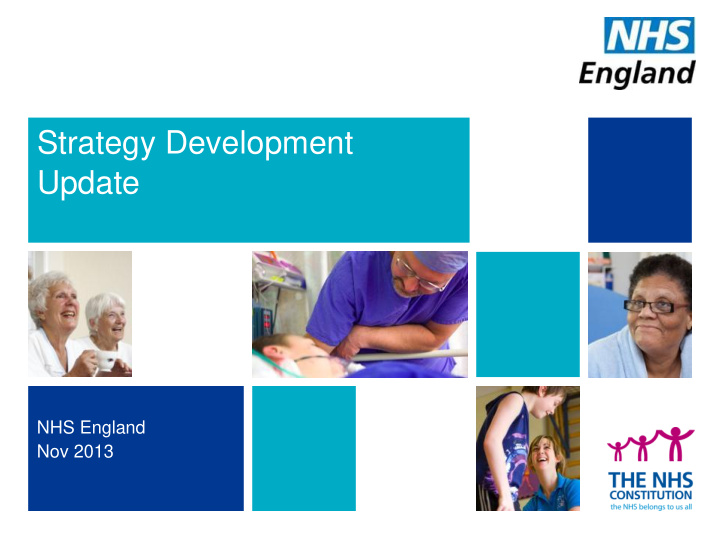



Strategy Development Update NHS England Nov 2013
Structure 1. Where do we want to be? 2. Where are we now? 3. How do we get there? 2
Where do we want to be? • Vision • Legal/policy context • Case for change 3 NHS | Presentation to [XXXX Company] | [Type Date]
Mandate commitment “to ensure the NHS becomes dramatically better at involving patients and their carers, and empowering them to manage and make decisions about their own care and treatment” The NHS Mandate, 2012 4
Vision • Authentic patient partnership – in their own care • Services provided 'with' rather than 'to' or 'for' people • Proactive, holistic, preventative and people-centred • Collaborative endeavour with active patient involvement and effective self-management support • Transforming the relationship between patients and clinicians 5 NHS | Presentation to [XXXX Company] | [Type Date]
Case for change? 6
Rise of multiple LTCs vs increasing medical specialisation. Personalisation essential Estimate for changes in co-morbidity patterns over the next decade, England What business 18 are we really in? One LTC Two LTCs Three+ LTCs 16 • 15m with LTCs Number with long-term conditions (millions) • Massive rise in 14 population with 12 multiple LTCs 10 • 50% GP 8 sessions • 77% bed days 6 • 70% spend 4 • Mostly self 2 manage, 5800 0 waking hours pa 2000 2008 2016 Sources: ONS population projections and General Household Survey 7 Source: Department of Health analysis of ONS projections and GHS
Recognising role/value of individuals/carers “Patient involvement is crucial to the delivery of appropriate, meaningful and safe healthcare…The goal is to achieve a pervasive culture that welcomes authentic patient partnership – in their own care” Berwick Report, 2013 8 .
Silent mis-diagnosis • The problem of the silent misdiagnosis is widespread. • Several studies show that patients choose different treatments after they become better informed. • Wide gaps between what patients want and what doctors think patients want. • Finally, there are dramatic geographic variations in care that can only partially be explained by causes other than the silent misdiagnosis. 9 NHS | Presentation to [XXXX Company] | [Type Date]
Stark financial position • 4% rise in activity pa. Pay for activity (PbR) not patient capacity. Need honest debate. • ‘ Call to Action ’ - £30 billion shortfall. Health Spending 1949-50 to 2010-11 10
Traditional NHS models will need to be radically rethought • Need to transform health care from a system that is largely reactive to one that is proactive, preventative and patient-centred and focuses on supporting patients to self manage. • Acute focused, episodic single disease models will not work alone. Need personalised care planning to support & manage multiple LTCs. • Active role for patients as PARTNERS, encouraged to become more knowledgeable about their condition(s) and more actively involved in decisions about their care. • Drawing on the asset value of individuals and communities – who have multiple resources that can be mobilised to help people live healthier and more fulfilled lives. 11
Passive Vs participative model of care Passive model Participative model Acute – Poorly informed patients and Acute – Informed patients & shared paternalistic treatment decision making Primary care - Single disease treated Primary Care - Personalised proactive reactively. 10 minute consultation care planned for multiple LTCs. Greater self management. Mental Health – treat and manage Mental Health – holistic support symptoms of disease. Dependency focused on wider personal goals. Greater self and peer support. Information one size fits all. Not a Information and support services built commissioned service into commissioning The consultation – single patient Consultation in groups, peer support, meets professional face to face expert patients, Skype Disjointed services for people with Integrated services and personalised 12 multiple morbidity. No care planning. care planning
Where are we now? 13
Where are we now? • Where is the NHS now in terms of patient participation? • What is the evidence base in terms of shared decision making, support for self-management, personalised care planning (and personal health budgets)? • What are the future trends (including technology and personalised medicine) and public health/life course perspectives? 14 NHS | Presentation to [XXXX Company] | [Type Date]
Where are we now? • What are patient/public enablers/barriers towards participation (attitudes/ability)? • What are workforce enablers/barriers to participation (attitudes/ability)? • Analysis of metrics, incentives and commissioning • Analysis of existing work programmes 15 NHS | Presentation to [XXXX Company] | [Type Date]
How do we get there? 16 NHS | Presentation to [XXXX Company] | [Type Date]
Whole system approach • Evidence of effectiveness and positive impacts on resource use and costs but gaps remains • Key challenges in terms of implementation – need whole system approach 17
House of Care 18 NHS | Presentation to [XXXX Company] | [Type Date]
House of Care Model • Centre of the house – person-centred, coordinated care • Left wall – engaged, informed individuals & carers • Right wall – health & care professionals committed to partnership working • Foundations – commissioning, metrics, incentives • Roof – organisational & clinical processes 19 NHS | Presentation to [XXXX Company] | [Type Date]
Next steps…… • Pull together and edit draft (currently 110 pages!) and identify draft priorities for action and research (Dec 13) • Share thinking with key internal and external stakeholders (with purpose to review and build partnerships) (Jan/Feb 14) 20
Recommend
More recommend